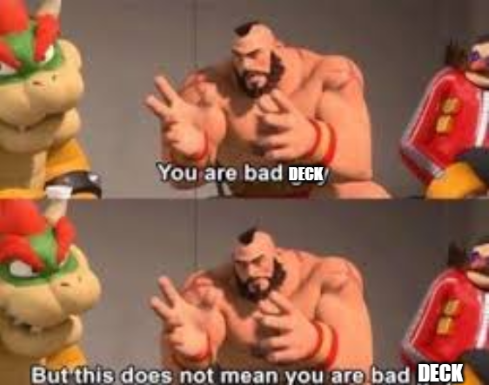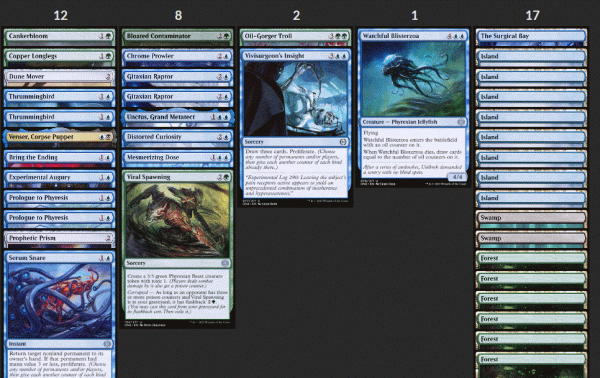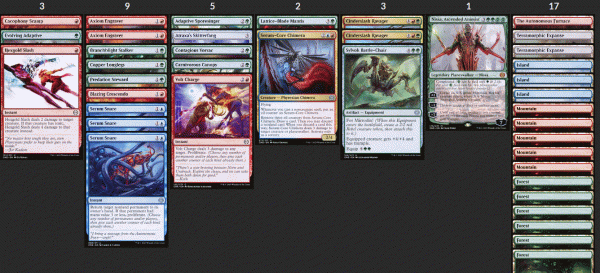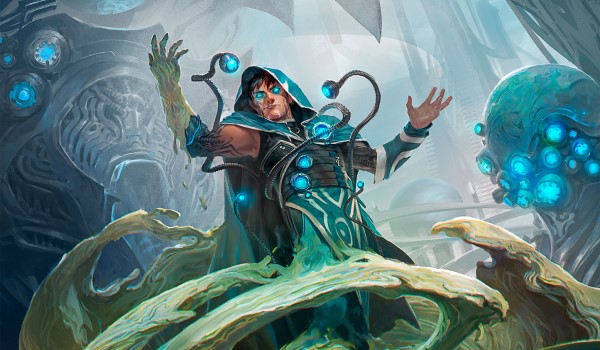Are you a Quiet Speculation member?
If not, now is a perfect time to join up! Our powerful tools, breaking-news analysis, and exclusive Discord channel will make sure you stay up to date and ahead of the curve.
Bad decks. Every format has them. We have decks that we're "supposed" to be looking for, and others we're supposed to avoid. But how can we?
Sometimes we chase an off-color rare into a disaster. Sometimes it's just hubris, a cloying urge to prove the pundits wrong. There are some occasions where we're just bored of drafting "the good colors." But eventually, we all do it. Eventually, we draft the bad decks of the format.
However, just because we're not doing the best thing in a format doesn't mean we can't profit, or even trophy with a "bad deck."
What Are the Bad Decks?
The good decks are more accurately described as "the desirable archetypes we should seek out in the draft, if our goal is to optimize our win percentage." In Phyrexia: All Will Be One (ONE), the decks that fall into this category can be described as meeting one or more of the following criteria:
- Decks with any two of the three Naya colors.
- Decks that have fifteen or more red cards.
- Decks with good, aggressive, cheap creatures.
- Base-white Toxic decks.
- The UW Artifact decks (although this is a little bit generous).
- Decks that want to win using a tempo-based strategy.
Conversely, the bad decks are likely to fall into these camps:
- Decks using any two colors in the Sultai Wedge.
- Three-color decks.
- Decks that are splashing without a great reason.
- Toxic decks relying on Pestilent Syphoner or Prologue to Phyresis.
- Decks that want to leverage an attrition-based strategy.

Just because we find ourselves building a bad deck does not mean that we should be resigned to punting our run. On the contrary, these decks often yield the most rewarding experience when we're able to be successful with a weaker strategy. However, to do this, we need to make sure we're cognizant of exactly what we're doing and how we plan to win.
Wrong Plan, Right Pieces
This deck basically checks off every box on our bad deck criteria. We aren't quite a three-color deck, but Venser, Corpse Puppet is a questionable splash. We're a blue deck, which, you know, isn't great. We're a little concerned about our early game, which is problematic in ONE. Nonetheless, this deck was able to get to seven wins.

7-2 UGb Proliferate
This deck is reliant on an early Prologue to Phyresis, which is the sixth worst common according to 17lands.com. Gitaxian Raptor, Mesmerizing Dose, Viral Spawning, and Oil-Gorger Troll are a slog to fight through. While we often don't want cards like Distorted Curiosity and Vivisurgeon's Insight in this format, but they played well in this deck. As we're dragging out a resource war, cards like this served as haymakers. We just need to know how to support them through gameplay.
Building this deck, I knew our clock would rarely be as fast as our opponent's. So we need to be able to trade, sometimes at a loss, and recoup the value later. We want to win the late-game, but if we fall behind early, there won't be a late game to win. Keeping a high life total is essential, especially when we don't have Bring the Ending for an opposing Hazardous Blast.
Playing Outside the Rules
This format has rigid rules of engagement, and we need to anticipate our opponents following them. With this deck, Prologue is a decent two-drop, but it doesn't line up well against Barbed Batterfist or Crawling Chorus. When we expect to fall behind, being able to double-spell early is very valuable. While drafting decks like this, we want to make sure that we're keeping our curve low. If we're going to take time off to draw cards, we'd better be ready to deploy them in a hurry.
Additionally, we're okay trading two-drops for combat tricks. The transaction slows our opponent from developing their board while saving damage. We can draw cards later, but our life total is fairly limited. It's one thing to "make them have it." In decks like this, we just need to make them use it.
Trained to Train Wreck
This started as a RG deck, but moved to blue, in the hopes of splashing a pair of Cinderslash Ravagers. We opened pack three and immediately greeted a Nissa, Ascended Animist. We couldn't shake the blue, but that was okay.

7-1 RUG Nissa
Early on in this draft, I was seeing powerful cards, but couldn't find a clear direction. Terramorphic Expanse and Axiom Engraver help in these situations together. Additionally, cheap interaction like Hexgold Slash and Serum Snare can hold together a lot of decks. This draft was brutal, but we were able to walk out of it with an absolute powerhouse because we sensed that conflict and were rewarded for adjusting to it.
When it comes to building a bad deck, we need to make sure that we have a good reason to do so. We had some really powerful cards, and because we prioritized facilitating pieces and cheap interaction, we were able to make it work. While I might have forced this concoction without all the glue, it would not have gotten to seven without those pieces.
Single-Card Showdown: Carnivorous Canopy vs. Ruthless Predation
Carnivorous Canopy is a card that is steadily climbing up my pick order. With the Naya colors getting more attention, our decks are forced to rely on marginal role-players, and this one always seems to step up. It's a great answer to Gitaxian Raptor or even a bomb like Bladehold War-Whip.
In a deck like this, I value a Carnivorous Canopy over something like Ruthless Predation. While the fight spell is the more powerful option, it's also more reliant on a streamlined approach. Fight spells are great when we're getting out in front of our opponent and playing creatures on-curve. This deck plays tap lands and three colors. As a result, we may not have our over-statted three- and four-drop down on the turn we want them. It may then prove tougher to maximize a fight spell.
A deck like this needs clean answers, and Carnivorous Canopy can do that, if not so flashily. In most decks we want the Ruthless Predation and it isn't close. In this deck, I'm prioritizing the Canopy.
Rules for Breaking the Rules
We should have a good reason to be in one of the format's bad decks. However, the best reasons strongly contribute to a plan. As always, the most important thing in deckbuilding is having a plan. As we draft, we need to prioritize the support cards for that plan.
Last week we talked about the contest of "better vs. more valuable," and while Terramorphic Expanse is not a great card in this format, it's more valuable than a lot of other cards to a three-color pile.
Additionally, just because we're breaking the rules doesn't mean we should anticipate our opponents to do so as well. Most people are (correctly) playing ONE as a tempo format. We need to anticipate aggression, and draft in a way that helps us in faster matchups.
Finally, the bombs in this format have been significantly diminished in the face of the rampant aggression. If we're not hiding behind the format's rules of engagement, we need to recognize that we're less protected from cards like The Eternal Wanderer and Thrun, Breaker of Silence. This means removal and interaction are at a premium. Hopefully our reasons to play this kind of deck includes answers to those threats or trumps to them.
"ONE" Final Note
Since drafting this article, I've seen a lot of content encouraging players to specifically draft blue. While I've provided my thoughts on the color, it may be a suboptimal time to experiment with the format's less-popular colors. While personal experience always represents a small sample size, I've found red to be more open than it should be, and RG Oil is still the easiest deck in the format to draft, and more often than not, Naya will yield far more success than the format's other colors.





